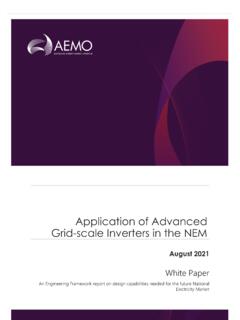Transcription of Green hydrogen production costs in Australia: implications ...
1 THE australian NATIONAL UNIVERSITY Crawford School of Public Policy Centre for Climate & energy Policy Green hydrogen production costs in Australia: implications of renewable energy and electrolyser costs Zero-Carbon energy for the Asia-Pacific ZCEAP Working Paper ZCWP03-20 CCEP Working Paper 20-07 August 2020 Thomas Longden, Frank Jotzo, Mousami Prasad, Richard Andrews Zero-Carbon energy for the Asia-Pacific Grand Challenge (ZCEAP) Crawford School of Public Policy, australian National University Abstract A crucial question in the development of a hydrogen industry is whether Green hydrogen , made using renewable energy , will be able to be produced at a cost that makes it attractive compared to hydrogen produced from fossil fuels. The main factors are the cost of electricity and the cost of electrolysers, together with capacity utilisation rates.
2 Over recent years the cost of electricity from solar PV and wind have fallen dramatically, and further reductions are expected. Cost reductions are also being realised for electrolysers. In this note, we compile recent cost estimates and projections to provide plausible ranges for the production cost of Green hydrogen . We find that the cost of Green hydrogen could readily be at or below A$3/kg in the near future, and that the stretch goal of A$2/kg mentioned in australian strategy documents is likely to come into reach, possibly rapidly. THE australian NATIONAL UNIVERSITY Keywords: Renewable energy ; hydrogen ; electrolysis; economic analysis; projections; levelised cost of electricity JEL Classification: Q41, Q42, Q47 Acknowledgements: We are grateful for feedback from several ANU colleagues and from other researchers. Suggested Citation: Longden T.
3 , Jotzo F., Prasad M. and Andrews, R. (2020), Green hydrogen production costs in Australia: implications of renewable energy and electrolyser costs , CCEP Working Paper 20-07, ZCEAP Working Paper ZCWP03-20, August 2020, The australian National University. Address for Correspondence: Frank Jotzo Crawford School of Public Policy The australian National University ANU College of Asia and the Pacific J. G. Crawford Building 132 Lennox Crossing Acton ACT 2601 Australia Tel: +61 (0) 2 6125 4367 Email: The Crawford School of Public Policy is the australian National University s public policy school, serving and influencing Australia, Asia and the Pacific through advanced policy research, graduate and executive education, and policy impact. The Centre for Climate Economics & Policy is an organized research unit at the Crawford School of Public Policy, The australian National University.
4 The working paper series is intended to facilitate academic and policy discussion, and the views expressed in working papers are those of the authors. THE australian NATIONAL UNIVERSITY I. Introduction Australia is one of several countries considering the creation of a hydrogen production , use and export industry. hydrogen can be produced from fossil fuels or through electrolysis of water. The latter offers the possibility of hydrogen produced without emissions of carbon dioxide. This Green hydrogen has been more expensive to produce than fossil fuel-based hydrogen , but its costs are declining. The two main factors determining the cost of hydrogen production from electrolysis are the cost of electricity and the cost of electrolysers. The cost of renewable electricity has fallen rapidly over recent years, and is expected to fall further. In many parts of the world, wind and solar power is already the cheapest form of energy for any new built generating capacity.
5 Its average cost is cheaper than electricity from natural gas in many places including Australia and is often cheaper than wholesale prices on the grid (IEA 2020, IRENA 2020, Graham et al 2020). Lower costs of electricity generation from carbon dioxide-free sources have fundamental implications for the choice of energy in many applications. Electrification of many processes and applications has become commercially attractive. production of hydrogen from fossil fuel-based processes currently dominates global hydrogen production , but hydrogen production based on renewable energy is becoming more competitive (IEA 2019). To date fossil fuel based hydrogen production has been cheaper than via the electrolysis route; however, hydrogen from fossil fuels is highly emissions-intensive unless coupled with carbon capture and storage, and even then there are significant remaining carbon dioxide emissions (Jotzo, Beck and Longden 2019).
6 This note takes stock of the development of renewable energy costs since 2010 and projections to 2050, and shows what different electricity cost levels and costs of electrolysers (coupled with different capacity factors) imply for the costs of producing hydrogen through electrolysis. It specifically looks at international and australian projections. It is intended to help inform current analysis in Australia about the likely future cost competitiveness of Green hydrogen . There is uncertainty about how costs for electricity and electrolysers will develop in the future, and the estimates presented here are not meant as a prediction of the future. THE australian NATIONAL UNIVERSITY We do not provide estimates for future costs of hydrogen from fossil fuel based processes. We also do not account for the (implicit or explicit) cost of any remaining carbon dioxide emissions, nor analyse the competitiveness of hydrogen with other energy carriers and energy sources (such as natural gas or direct use of electricity in different applications and places).
7 II. Renewable energy supply costs Typical up-front capital costs for solar PV installations fell by 79% from 2010 to 2019 and by 24% for onshore wind generators (IRENA, 2020). This means lower average costs of generating electricity over the lifetime of assets (Figure 1). The levelised cost of electricity (LCOE) for large scale solar PV installations in 2020 is between A$41-60/MWh in Australia according to CSIRO estimates ( GenCost , Graham et al., 2020), and A$49-64/MWh internationally according to the IRENA auction The equivalent numbers for onshore wind are A$48-60/MWh (Graham et al., 2020) and A$46-64/MWh (IRENA, 2020). The LCOE is a measure of average electricity generation costs over the lifetime of a generating plant. The expected future trend is for further reductions in costs from solar PV with a projected mean LCOE in 2030 at A$33/MWh, which drops to A$26/MWh in 2040.
8 Onshore wind is projected at a mean LCOE of A$46/MWh and A$43/MWh for 2030 and 2040, respectively. However, offshore wind has seen recent dramatic reductions in recent costs that have been reflected in the global average auction price dropping from A$181/MWh for 2020 to A$117/MWh for 2023, with prices in the lower ranges (5th percentile) between A$77/MWh and A$101/MWh for 2020 to 2023 (IRENA, 2020). The mean cost projection for 2030 across both PV and onshore wind is A$40/MWh, and the lowest estimate was A$25/MWh (Figure 1c). In the analysis that follows we refer in particular to mean cost estimates and projections. This is a highly conservative approach for two reasons. 1 All monetary values in this note are given in AUD. Many estimates are in USD in the original materials, currency conversions are all at 1 AUD = USD.
9 THE australian NATIONAL UNIVERSITY One, production of hydrogen using electrolysis would almost always make use of the cheapest available electricity generation options. Therefore it is the lower range of present and projected future costs that is relevant, not the higher-cost installations in locations that are not optimally suited for renewable energy generation. Two, the history of renewable energy projections has been to underestimate capacity and overestimate investment costs (Carrington and Stephenson 2018, Gilbert and Sovacool 2016). One factor that suggests that reality may once again lead to lower costs than currently projected is that capital is now available at very low cost, and interest rates are likely to remain low on account of a global recession. Note that the IRENA LCOE calculation applies an interest rate of for the OECD and China over a lifetime of 25 years.
10 THE australian NATIONAL UNIVERSITY Figure 1 Levelised cost of electricity 2010-2020 and projections to 2050 a) Solar PV b) Onshore wind c) Both solar PV and onshore wind Sources of these data are: Bloomberg NEF (2020), Graham et al., (2020), IRENA (2020), IRENA (2019a,b), Lazard (2019). Values in USD have been converted to AUD. THE australian NATIONAL UNIVERSITY III. production costs of hydrogen via electrolysis The cost of electricity is a major cost component in production of hydrogen via electrolysis. The other defining cost components are the efficiency and capital cost of electrolysers, in combination with the capacity utilisation of electrolysers. Other costs , such as labour, land and water, are a minor determinant of the production cost of hydrogen (IEA, 2019). IEA (2019) provides a breakdown of capital costs by electrolyser type.





